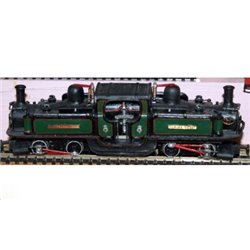So the kids have all grown up and moved away, you finally have a little space, a bit of extra cash maybe, and a...
No products
Product successfully added to your shopping cart
There are 0 items in your cart. There is 1 item in your cart.
Search Tips
Christmas and New Year
We are dispatching orders every weekday apart from Christmas Day, Boxing Day and New Year's Day.
If you order is time critical, select next day delivery at checkout.
The shop in Sandown is closed from 25th December, reopening on 30th December.
What is meant by the term 'Fairlie' Locomotive and where were they operated ?
The term 'Fairlie' locomotive refers to a unique type of steam locomotive that was designed by the engineer Robert Francis Fairlie in the mid-19th century. Most Fairlie locomotives were characterized by having a double-ended design, with a boiler and cab on each end of the locomotive, and a central articulated frame connecting the two ends. This design allowed for improved stability and maneuverability, especially on curves and uneven track. These were usually called Double Fairlies.
Single Fairlies were developed at a later stage and were basically half a Double Fairlie, comprising a single boiler, a single cab, and a single bogie with an unpowered bogie located under the cab. Mostly used in the US, a Single Fairlie is currently used on the Ffestiniog railway.
Fairlie locomotives were primarily used on narrow-gauge railways, particularly in mountainous regions where sharp curves and steep gradients were common. They were particularly popular in countries such as Wales, New Zealand, and South Africa, where the challenging terrain required specialized locomotives. Fairlie locomotives were also used in other parts of the world, including parts of Mainland Europe and South America.
One notable example of Fairlie locomotives in operation is the Ffestiniog Railway in Wales, which has been using Fairlie locomotives since the mid-19th century. These locomotives were instrumental in hauling slate from the quarries to the coast for export. Another example is the famous Talyllyn Railway, also in Wales, which operates a fleet of Fairlie locomotives on its narrow-gauge line.
Fairlie locomotives are still in operation today, and many have been preserved and restored by railway enthusiasts. They are admired Worldwide for their unique design and their ability to navigate challenging terrain.
Click here to receive the tips weekly in your mailbox. You can unsubscribe at any time.








